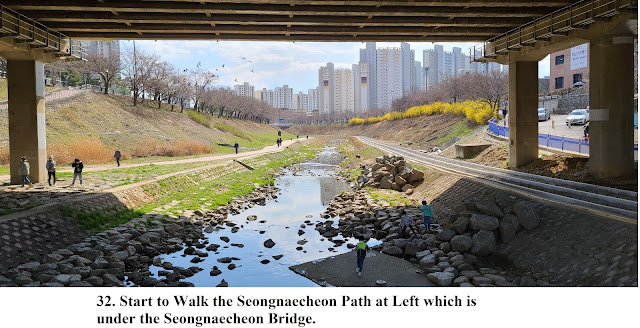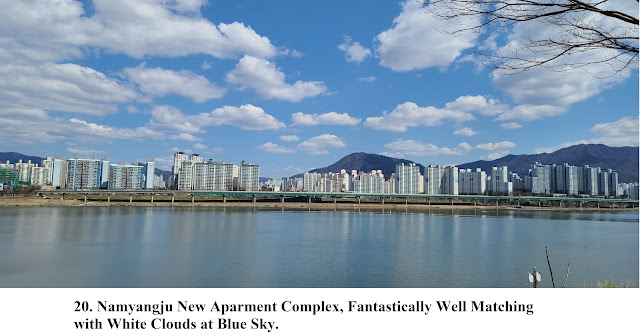1. Preface
Hangang River is one of Major River in Korea
which is starting flowing down from the Taebeak City in Gangwon Province, North
East to the Ganghwa Island in West Sea and which is almost dividing half of
country from North to South. Total flowing distance is estimating as 494km.
There are total numbers of bridges built around Seoul and it’s metropolitan in the
Hangang River as 32 pieces. But I will arrange to walk Hangang River from
Gangseogu district to Hanam City in Kyeonggi Province which is estimated as
total distance, 86 km and 26 walking hours and passing 22 bridges out of these
total 32 bridges. Each course is principally arranging based on about 13 km
distance and 4 hours walking time and starting from near subway station and
finishing at designated subway station. Please see more to Attached Walking
Course Summary Table and map below for bridges on the Hangang River.
2. Course Guide Information
Hangang River Walking Trek (HRWT) Course 6 is
arranged from the Misa Station to the Hanam Geomdansan Station in the Seoul
Metro Line 5 as about 13 km walking distance for about 4 hours including one hour
break. We will pass Misa Daegyeo Bridge at the Hangang River and five
Seongnaecheon Bridges at the Seongnaecheon Brook during the course as shown at
the summary map of the Course 6 as attached below. Please refer overall Video
summary linked to https://www.youtube.com/watch?v=1Wzddj6AFDo
2-1) Start the Gate 4 at the Misa Station in
Seoul Metro Line 5 and move toward the Misa Sagueri Junction via Arisuro
Junction as see at the Photo 1~ 6.
2-2) Move Forward the Hanam Tree Orphanage
through Misa Daero (Main Street) as see at Photo 7 ~10.
2-3) Walk toward the Junction with the HRWT
Course 6 via Hanam Orphanage Entrance and Gangil Over-Bridge Junction as see at
Photo 11~14.
2-4) Keep walk toward the Seongnae Bridges
alongside the Hangang River and enjoying so sweet nature view alongside Hangang
River as see at Photo 15~38.
3. Historic and Background Information
There are several places or spot where some
cultural and historic background which you may feel interest in or useful for
your better understanding. Please refer followings for brief explanation.
3-1) Hanam
City
The King Onjeo at Baekje Period was establishing
his capital at this place as calling as a Wuiraeseong
city and his subsequent kings and King Gaero, 21th King in Baekje Period were
continuously controlling this capital for 494 years until the King Jangsu in
the Goguryeo Period took over. Therefore King Gaero moved his capital to
Woongjin area, presently calling as Gongju City. The Goguryeo was naturally
changing the Wuiraeseong City to Hanju City which was changed again by the King
Taejo, founder of Goryeo Empire to the Gwanju as the same name as present name.
This area was upgrading calling as Dongbu Myeon Town at the King Seonjo
controlling period 10 years in Joseon Dynasty (Village to Town Upgrading). This
area was reorganized as Gwangju City in 1989 under merging three Gwangjugun
District, Dongbu Eup Town and Jungbu Eup Twon and Seobu Myeon Town.
3-2) Deokpoong Cheon Brook
.The Deokpooncheon Brook was originated somewhere
in the Namhansanseong Castle area and flowing down to the Hangang River via
middle of Hanam City which is ultimately
reaching to the West Sea. There were upper Warehouse and lower Warehouse in
Joseon Dynasty which were storing grains and others for collecting from the
people as a relevant tax since convenient transportation through at this area
through the Hangang River by the yellow brown mast vessel. This Deokpoongcheon was
becoming swallowing time by time and naturally changed to woman’s laundry
places or children’s playing area or man’s fishing area which is no more nowadays.
There were many marsh snails which was a good diet to firefly and water parsley
paddy one time before which is no more this scenery. Local Government made a
effort to recover nature scenery and made proper living or mating area at the
brook where carp are easily and comfortably living and mating since people used
to see carp’s mating scene at the brook.
.
3-3) Geomdansan Mountain
Geomdansan Mountain, 657m above sea level
is elegantly soaring at the Hangang River at the East of Hanam City which is
facing Yebongsan Mountain, 679m above sea level across the Hangang River. It is
legend that the Geomdan Buddhist Monk was living at this Geomdansan Mountain
one time who was putting mountain name as his name as Geomdan or many goods
arrived at this area from various places which were waiting for inspection by
authority because Geom alternatively means inspection.










































댓글 없음:
댓글 쓰기